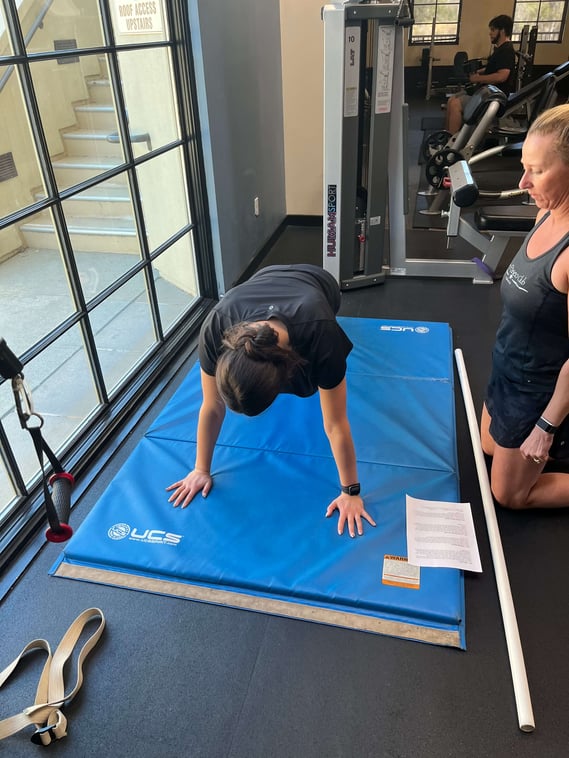What is a fitness assessment — and what to expect at your first one
August 31st, 2022 | 5 min. read
By Jen Azevedo
If you are new to fitness or are returning to a more active lifestyle after some time away, it can be hard to know where to begin. Gyms have tons of equipment and exercise classes to choose from. But knowing how to train safely and what movements to focus on is another issue altogether.
Paseo Club has experienced instructors who help people of all athletic abilities learn about their strengths, weaknesses, and how to move while minimizing the chance of injury.
In this article, you learn what a fitness assessment is, its benefits and drawbacks, what movements get reviewed, and why you should get assessed in the first place.
What is a fitness assessment?
A fitness assessment is an exam that evaluates a person's range of motion, body mechanics, overall health, and body composition.
The instructor looks for what the client needs help with the most and makes suggestions accordingly.
There are four components to a fitness assessment.
- A health and exercise history questionnaire
- Weigh-in, body fat percentage, and inches measurement
- Warm up with some form of cardiovascular exercise
- Functional Movement Screen (FMS) comprises four movements
Health and exercise questionnaire
The questionnaire is a 22-question-long form that covers several topics relating to your health and well-being.
- Diet
- Injuries
- Medications
- Prior surgeries
- Heart conditions
- Prior and current fitness regimen
- Your approach and feelings towards exercising
Weight and body composition measurements
Body composition metrics are used to provide a thorough assessment of the individual's muscle and fat percentages.
The right balance of fat and muscle is vital for health and wellness. Evidence shows that maintaining a healthy body composition increases longevity and reduces the risk of heart disease, cancer, and diabetes.
Baseline measurements are essential to have before beginning any new fitness plan. As you spend more time engaging in a regular exercise routine, you become stronger and more fit and your body composition changes.
Remeasuring your body composition in 3-6 months quantifies the progress made.
Weight: All clients weigh themselves. It is a helpful metric, but because muscle weighs more than fat, it is not a complete picture by itself.
Body fat percentage: This measurement is taken using a handheld tool that uses the bioelectrical impedance method which sends an extremely low-level electrical current of 50 kHz and 500 µA through your body to determine the amount of fat tissue. This weak electrical current is safe and is not felt while operating the monitor.
Inches measurements: A cloth tape is used to measure the circumference of the client's chest, waist, hips, arms, and legs.
Cardio warm-up
A cardio warmup consists of mild to moderate aerobic activity such as biking on an indoor bike or jogging on a treadmill.
The purpose of the cardio warmup is to raise your heart rate and core temperature and increase blood flow to muscles. This step is helpful for preparing your body to safely do more strenuous activity – namely the FMS.
The functional movement screen (FMS)
While a person is performing the screening, they are observed and notes are made about their range of motion and body mechanics to see what they need help with most.
Test 1: Deep squat
Squats are the main component of most lower body exercise programs. A deep squat is a movement that requires flexibility of the hips, knees, and ankles, and under weight, utilizes the core and glutes.
To do a deep squat, you place the feet shoulder-width apart in alignment with the outside of the shoulders. The toes point straight ahead. Rest a dowel on top of your head and keep the elbows at 90 degrees.
Descend slowly as deep as possible into the squat position with the heels on the floor and the dowel pressed overhead. Pause for 1 second at the bottom of the squat before returning to the original position.
Test 2: Shoulder mobility
The shoulder mobility test evaluates flexibility, mobility, flexion, and extension of your shoulder joint.
Standing with the feet together, making a fist with the thumbs tucked inside. Reach one arm over and down the back while simultaneously reaching the opposite arm up the back. Moving in a smooth motion, reach the fists as close together as possible.
Test 3: Active straight leg raise
The active straight leg raise assesses the load capacity of the pelvic girdle and any pain that comes from neural or disk injury.
Begin by lying down with the palms facing up and the arms at a 45-degree angle from the shoulders. The backs of the knees are over a board, and both feet are in a neutral position. The soles of the feet are perpendicular to the floor and touch together.
While slowly raising one leg as high as possible, keep the opposite knee in contact with the board and the hands and arms in the same relaxed position. Once you reach the end range, pause and lower the leg to the original position.
Test 4: Trunk stability push-up
This movement is a test of core strength and stability.
You lie prone with your arms flexed. The thumbs are placed at the top of the forehead, chin, or shoulder level, per the scoring criteria. The legs are straight, and the soles of the feet are perpendicular to the floor.
Perform a push-up from this position, raising the body off the ground in one unit with no sway in the spine.

Who needs a fitness assessment?
A fitness assessment is for anyone who has not worked out in a long time or is trying to improve their mobility, strength, and/or body mechanics can benefit from a fitness assessment.
Why does a person need a fitness assessment?
People use the fitness assessment because it creates a baseline, giving them data to compare to as they progress. It allows the person to see an advancement in their skills, abilities, and body measurements from one test to another.
What information does a person learn from their fitness assessment?
A person who gets a fitness assessment receives feedback about their fitness level, endurance, body composition, and general health. They also learn exercises that support their bodies and that complement their goals.
What are the benefits of a fitness assessment?
A professional analyzing your movement patterns gives you a better understanding of your body. Oftentimes people do not know how to squat correctly or perform a specific exercise that would increase their range of motion.
Participants come away with more knowledge on how to use equipment and do new exercises.
An assessment can also be a time to plan and set goals because you have more knowledge about what areas need to be improved.
Are there any drawbacks to a fitness assessment?
The only drawback is the possibility of finding out that things you thought you were doing correct may have been causing your body damage.
Do people need to have follow-up assessments?
Typically, a repeat assessment is done between three and six months after the initial one. This is a time to track how far the person has improved in their cardio, endurance, and strength capacity and to see if there are any changes in body composition.
A follow-up session is also recommended to review the programming the person has engaged in and to make any changes or updates to their regimen.
Final thoughts on getting a fitness assessment
Being physically active is an important way to take care of ourselves. It enhances mental well-being, improves heart health, and provides the opportunity to foster social connections.
But staying safe and preventing injuries is an essential part of exercising. A fitness assessment can be an important diagnostic tool for learning about your abilities and how to do many basic movements accurately.
The Paseo Club offers FREE initial fitness assessments to members to help them get started on their fitness journey on the right foot.
Members use the knowledge they gained to train independently, attend one of our 60+ fitness classes, play tennis or pickleball, swim in the junior-Olympic pool, or work out privately with a personal trainer.
Are you trying to figure out to develop an exercise regimen but aren’t sure which way to turn? Read what are the eight important steps to begin a workout routine.
Curious about what is popular at the Paseo Club? Check out the top ten fitness classes.
You can also see the classes in action by swinging by the club for a Paseo Club tour. Schedule one today, and then check out the courts, pool, cafe, spa, and a childcare center.
Jen Azevedo is a tennis professional, pickleball professional, personal trainer, group exercise instructor, and the general manager of the Paseo Club. She loves the community at the Paseo Club and that it is also a safe and fun place for her daughter. Jen’s favorite activities are joining her tribe for trail races or her partners for tennis matches. Occasionally Jen slows down to relax with a book — she reads over 100 a year!

